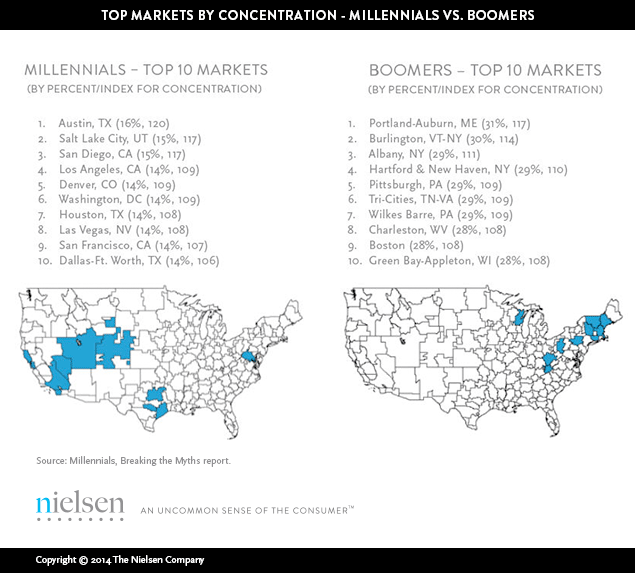Millennials Prefer Cities to Suburbs, Subways to Driveways [INSIGHT]
March 8, 2014
![]() Millennials are the social generation, both online and in-person. As the founders of the social media movement, they’re never more than a few clicks away from friends and family. And offline, they prefer to live in dense, diverse urban villages where social interaction is just outside their front doors.
Millennials are the social generation, both online and in-person. As the founders of the social media movement, they’re never more than a few clicks away from friends and family. And offline, they prefer to live in dense, diverse urban villages where social interaction is just outside their front doors.
Breaking from previous generations’ ideals, this group’s “American Dream” is transitioning from the white picket fence in the suburbs to the historic brownstone stoop in the heart of the city. And their dreams have the power to affect cities and towns across the U.S. According to Nielsen’s recent Millennials – Breaking the Myths report, those aged 18-36 are 77 million strong, or 24 percent of the population—the same as Baby Boomers (between 49-67 years old). As Millennials continue to come of age and control an increasing share of the economy, understanding how their diversity and values play into their lifestyle and purchasing preferences will be essential to appeal to this generation of consumers.
A Metropolitan Feel has a Millennial Appeal
Millennials like having the world at their fingertips. With the resurgence of cities as centers of economic energy and vitality, a majority are opting to live in urban areas over the suburbs or rural communities. Sixty-two percent indicate they prefer to live in the type of mixed-use communities found in urban centers, where they can be close to shops, restaurants and offices. They are currently living in these urban areas at a higher rate than any other generation, and 40 percent say they would like to live in an urban area in the future. As a result, for the first time since the 1920s growth in U.S. cities outpaces growth outside of them.
The markets where Millennials are most highly concentrated reflect their desire to live in more socially conscious, creative environments. Austin, Texas has the highest concentration of this group—almost 1.2 times the national average—and fits the Millennial ideal, combining urban convenience with an exciting art and music scene. Within Austin, most Millennials are found near the city core and less in the suburban and rural areas. With the exception of Washington D.C., the top markets for Millennials are in the western portion of the country, unlike their Boomer counterparts who are mostly highly concentrated on the East Coast. And the growing young population in the Western U.S. will affect demand in these areas.

Bringing the City to the Suburbs
The suburbs can appeal to Millennials’ desire for a metropolitan feel by transforming into “urban burbs.” San Francisco-based architect Peter Calthrope’s concept of New Urbanism has taken successful urban design principles and applied them to suburban development. By emphasizing diversity in both community design and population, developers can speak directly to the values of Millennials. These new communities are simultaneously pedestrian- and transit-friendly, environmentally conscious, and incorporate mixed housing types (single-family, townhomes and apartments) and public parks for community gathering.
Recently, cities like Miami, Memphis, San Antonio, Portland and Jersey City have adopted New Urbanist principles, making their suburbs more attractive to Millennials. Specifically, these cities are attracting older Millennials (and their higher median incomes of $48,000, compared with those of younger Millennials at $25,000), who may be starting families but still want the vibrant feeling of an urban environment.
Though Less Mobile, Millennials Are Moving Frequently
Because they tend to live in more urban areas, Millennials are also less likely to own cars–and vehicle ownership rates are declining. In 2011, 66 percent of Millennials under age 25 owned a car, compared with 73 percent in 2007. Those who do own cars put a premium on being green, in line with their passion for environmental causes. As a result, they’re more likely than Boomers to pay more for environmentally friendly vehicles.
Also in line with urban-living, most Millennials aren’t putting down roots just yet. Two-thirds of Millennials are renters, and they’re more likely to live with roommates or family members than alone. Millennial homeownership has fallen largely due to the recent recession: 14 percent of Millennial homeowners went back to renting in 2011, compared with 4 percent of the general homeowner population. With lower Millennial homeownership rates and a preference for city living, Boomers could face problems downsizing. And that’s no small number—50 percent of Boomers say they want a smaller home when their kids leave the nest.
The Potential Power of Millennials
Millennials who aren’t in the city are likely still in the suburbs with mom and dad—almost a third lived with their parents in 2010, up from 25 percent in 2005. Millennials have been hit hard by the recent turbulence in the economy, but their high education levels and optimism as consumers foreshadow their potential future success. The Demand Institute predicts that by 2017 the percentage of Millennials living with their parents will decrease as the economy recovers and they’re able to find jobs to kick-start their careers.





























